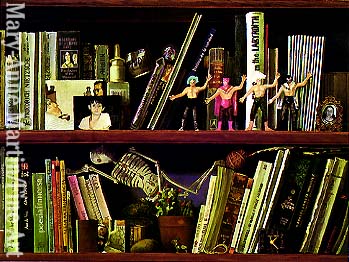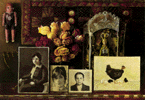
29. Bookshelf, 1994
|
The presence of Mexico in some of Climent's recent
paintings has altered and become, in a sense, more conceptional.
Several still lifes, Three Cactus Plants and Flowers with Wristwatch , for
example, include envelopes edged in green, red, and white, that is, letters
sent from home by friends and family. These trompe-l'oeil letters signify
their foreign origins, and they recall the faithful transcriptions of two
dimensional objects in the work of American nineteenth century painters
William Harnett and John Frederick Peto. Climent, like them, constructs her
still lifes in shallow spaces, thus accentuating the illusionism of the work
and creating an intimacy that further intensifies her work.
Photographs too,
are more evident in her current work and also speak to her past, to her
legacy. Climent is especially challenged by trying to reproduce photographs
in her work, but she has always pushed herself to conquer the formal rules of
anatomy, perspective, composition and color. Much of her training was
selfimposed: she copied works of art, imitated artists, studied anatomy in
books, sketched obsessively, visited museums, experimented with color, and
in the end, taught herself these very techniques that were regarded with
suspicion by artists of her generation. Her father, also an artist, discouraged
her from attending art school, fearing a traditional education would do more
harm than good. Thus while the younger Climent is virtually self-taught, her
isolation created an anxiety about what she might be missing; by overcoming
the technical hurdles, she is now allowed the freedom to reproduce what she
sees and express the emotional charge the objects have for her.
Climent's
works reverberate with a tension between their emphatic realism and the
opacity of their meaning, between knowing they are painted and wanting
them to be real, between their anonymity and the implication that their
presence is vitally important. Climent thinks of her paintings as "windows
on memories" and the viewer never ceases to enjoy the exquisite fissure
between perception and comprehension that these paintings
arouse.
Sarah M. Lowe, April 1995












